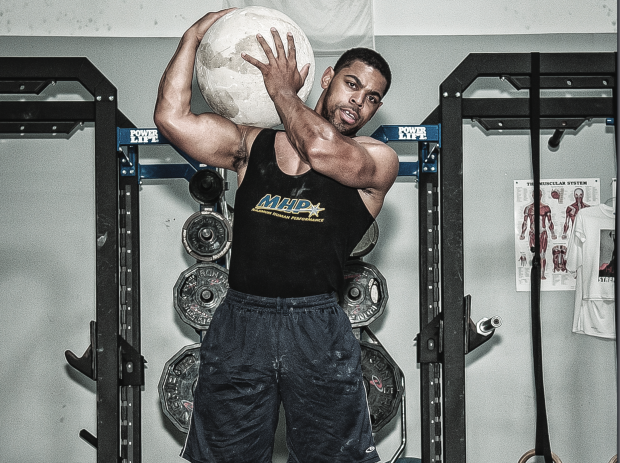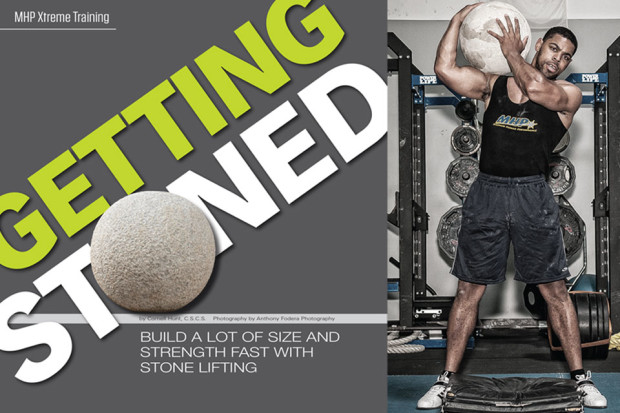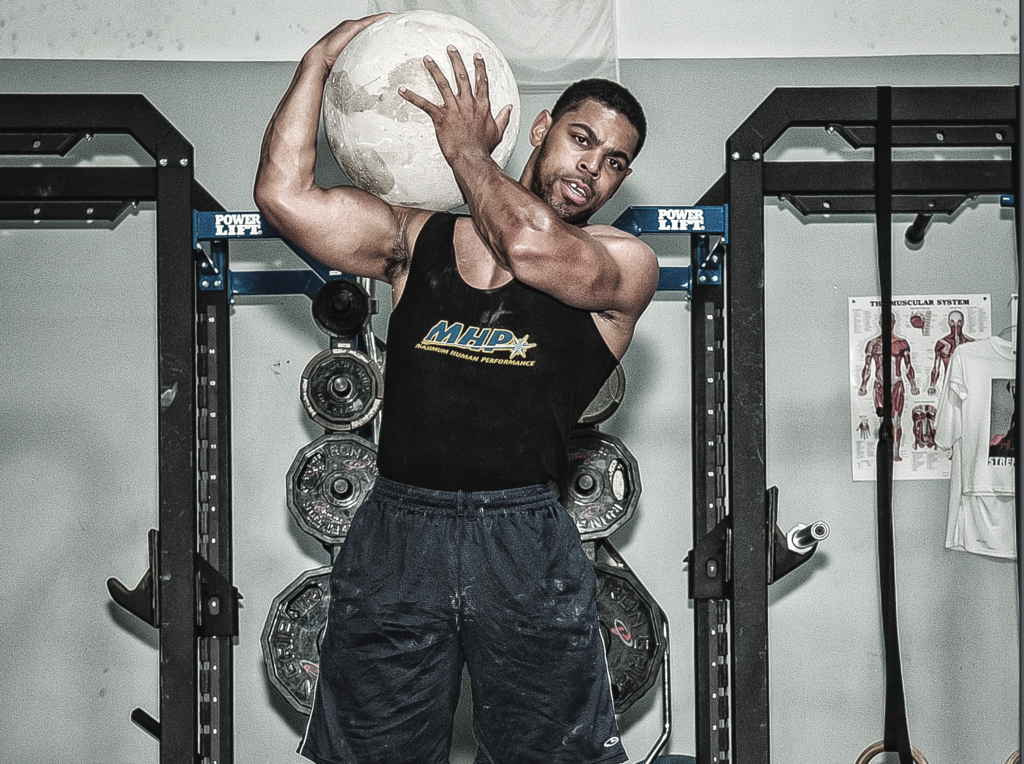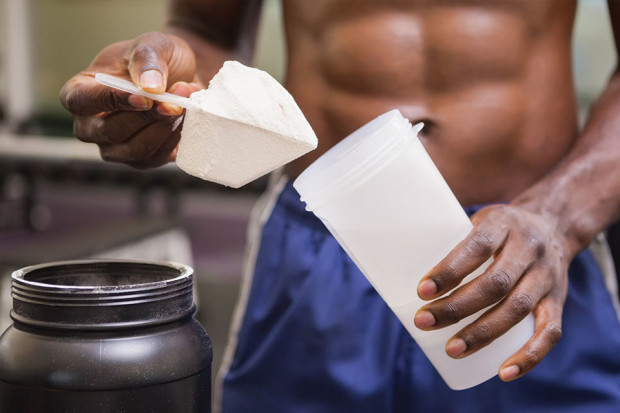


There are certain types of lifts that every daring man should try. You have many tools to choose from when designing a training program, but there are a few exercises that separate the men from the boys—literally!
In Scotland, “manhood stones” have long been used as tests of strength to welcome boys into manhood. Stone lifting competition is very common in northern Europe, particularly in Scotland and Iceland, where stones were used to qualify men to work on fishing boats. In Basque Country, in northern Spain, it’s become a traditional sport as well.
In America, which tends to fall behind in all things strength related, fans and athletes have only recently picked up on the excitement of this activity. Now you can see stone lifting on ESPN during strongman competitions, and with the growth of the functional-fitness craze, many gyms and training facilities have areas dedicated to stone lifting.
BENEFITS OF STONE
Not sold yet on the power of hoisting stones? Check out some of these benefits.
First off, if being a powerful guy isn’t enough, then you’re thumbing through the wrong magazine. Stone lifting is one of those exercises that many dream about doing but only a few dare to try. If you’ve seen a strongman competition, you know that most of them look like guys you would call if you needed help with a little head banging in the local pub.
Lifting stones is only visited by a few brave souls, and for that reason it remains a niche in the strength training world. As with most things in life, however, with risk comes reward. Regularly scheduled stone lifting, similar to most resistance training, will increase testosterone, a benefit that doesn’t have to be explained to IM readers. By increasing testosterone, you open up yourself to creating eye-popping muscle. As men get older, their testosterone decreases, so doing everything you can to keep testosterone levels high should be a priority to men, young and not so young. Stone lifting will not only place you in an elite cadre among your friends and fellow gym rats, but it will also get you stares from the ladies. And of course, you’ll have the testosterone to back it up, if necessary.
HITTING THE POSTERIOR CHAIN
When done correctly, most compound exercises target the entire posterior chain, the muscles along your backside: glutes, biceps femoris, traps, even rear delts. Stone lifting is no different. It will increase strength in major prime movers back there. If one of them is lacking, stone lifting will help to expose the weakness and then help correct it. The term “total-body strength” is thrown around much too lightly these days, but stone lifting is a tried-and-true total-body exercise. Not only will you feel it in your posterior chain, but it’s great for building your forearms and creating crushing grip strength. I often tell the guys I work with that callused hands and scars are a badge of honor. Creating strong forearms and a strong grip are only two of many benefits that stone lifting can provide.
MORE CORE STRENGTH
How about true core strength? The world is often driven by aesthetics, and sometimes we mistake sharp abs for strength. In truth, if you can see someone’s abdominals, he or she may have either great genetics or a strict diet plan. I know many people who have etched abs but still suffer from back pain. Any real strength and conditioning coach will tell you that the true function of abdominal power is to absorb and control movement or outside forces. Powerlifters and strongman, for example, have insane levels of core strength. MMA fighters do as well. To place a heavy barbell on your back or take hits to the stomach, you must have sufficient abdominal strength. Lifting stones will help to create it. Controlling your spinal position and having the strength to withstand the forces created by the stone will help to develop your core strength.
WHAT ABOUT CARDIO?
As a trainer I like to place premiums on cardio, but while there’s cardio that people do by running on a treadmill or riding a bike for an hour, there’s also much tougher cardio. You can throw stone lifting into that category. It’s a great tool for finishing a grueling workout or getting in a time-crunched session. What’s more, as total-body exercises are proven to be effective in shedding bodyfat as well as building strength, stone lifting, when done correctly, aids in that as well.
ABDOMINAL BRACIN
GAs you can see, stone lifting offers tremendous benefits—but you must do it with caution. There’s a special technique for lifting stones in a safe and effective manner, and it’s important to have a firm understanding of abdominal tension and bracing. Creating abdominal tension and bracing is beyond the scope of this article, but if you ever attempt a maximal lift, you should know how to brace your abs. In life and in lifting, a braced neutral spine will keep you safe and pain-free. Many people hurt themselves when they don’t keep a neutral spine with lifting and moving objects; however, stone lifting will not allow for a perfectly neutral spine. In order for you to get your hands around the stone, your spine must lose its arch and go into spinal flexion, but you should be able to know the difference between lower-back extension and middle-back extension. When you’re lifting stones, middle-back, or thoracic-spine, extension will occur, especially at the setup.

Here’s how to do it:
1) Walk up to the stone and straddle it. You want to get the most leverage possible, as in a squat or deadlift. Hinge your hips back and squat down to grab the stone. Place both arms around the bolder as if you were giving someone a bear hug at the three o’clock and nine o’clock positions.
2) Engage your lats, and pull in air through your stomach to create spinal stability and abdominal tension.
3) Press down through your legs and get the stone up off the floor.
This is where it gets tricky.
Lighter stone: When using a lighter stone, you want to explode the stone upward by using your hips in an explosive fashion. This will enable you to bring the stone up to your chest or shoulders, depending on what exactly you are doing.
Heavier stone: If the stone is heavy, you’ll have to make this into two separate movements. The first movement requires getting the stone to your thighs. Then bring your legs together and allow the stone to rest on your quads as you regrip—advanced strongman and stone lifters will now place their hands in at two o’clock and 10 o’clock or one o’clock and 11 o’clock. Then explosively drive your hips and bring the stone up to your chest. Make sure you squeeze your glutes as they come up to take pressure off of your lower back.
In competition, this is typically where the lift ends—the strongman places the stone on a platform or shelf and then grabs another (usually heavier) stone and repeats for as many rocks as needed. In the gym, however, most cross-training athletes hoist the stone up to shoulder level to finish the lift and then drop it back onto the pad in a controlled fashion, being careful not to slam it on their feet. (The pad on the floor will help control rolling.)
PRACTICE, PRACTICE
Irrespective of whether you’re using a light or heavy stone, stone lifting requires considerable practice, so make sure you get comfortable with the technique before taking it on seriously. Once you learn the technical art of stone lifting, you can then begin adding it to your training program.
Until you become good at it, designate some time before your regular training session begins, when you are well rested. I would also suggest that you practice it on an off day or a lighter day in the gym. You can work stone lifting into your training program in numerous ways, and variation is encouraged. For every maximal lift, I suggest going heavy with the stones at the beginning of your session. If you have other things planned for the day, go heavy at the beginning, after your warm-up, so you can give it your all, as your central nervous system is primed for maximal effort.
As mentioned earlier, you can do stone lifting by placing the stones on top of platforms of varying height, or you can have a bar placed at a challenging height that requires you to lift the stone over it and drop it on the other side.
MORE ADVANCED
Then there is stone shouldering, which requires you to lift the stone from the floor to each shoulder, alternating every time. The exercise you are doing will determine how you proceed.
If you’re looking to compete in a strongman event, you will obviously need to train stone lifting multiple times a week; however, if you are just looking to add it to your regular program, I recommend giving the stone some attention at least two days per week—one day for strength building and another for more of a high-intensity cardio-based session. How you schedule it depends on your training split.
WHEN AND HOW
If you group your training into total-body splits, you can get away with doing stone lifting on any of those days. If you train in a more traditional bodypart split, I recommend adding it on your leg or back days. Since stone lifting can be compared to deadlifting in terms of picking something up from the floor, whenever you are scheduled to train deadlifts, you can replace them with stone lifting. (Some people train deadlifts on leg day, and others train deadlifts on back day.)
One of my favorite training variations is to combine stone lifting with strongman medleys. Do stone shouldering with tire flips and farmer carries for a great cardio-conditioning workout. It sure beats the treadmill.
As you can see, stone lifting provides many benefits, but you must approach it with caution. While it’s far from traditional lifting, hoisting odd objects will put you into a different league. In one form or another, it should be a part of every serious lifter’s arsenal.
SUBSCRIBE TO IRONMAN AND READ MORE






















You must be logged in to post a comment Login